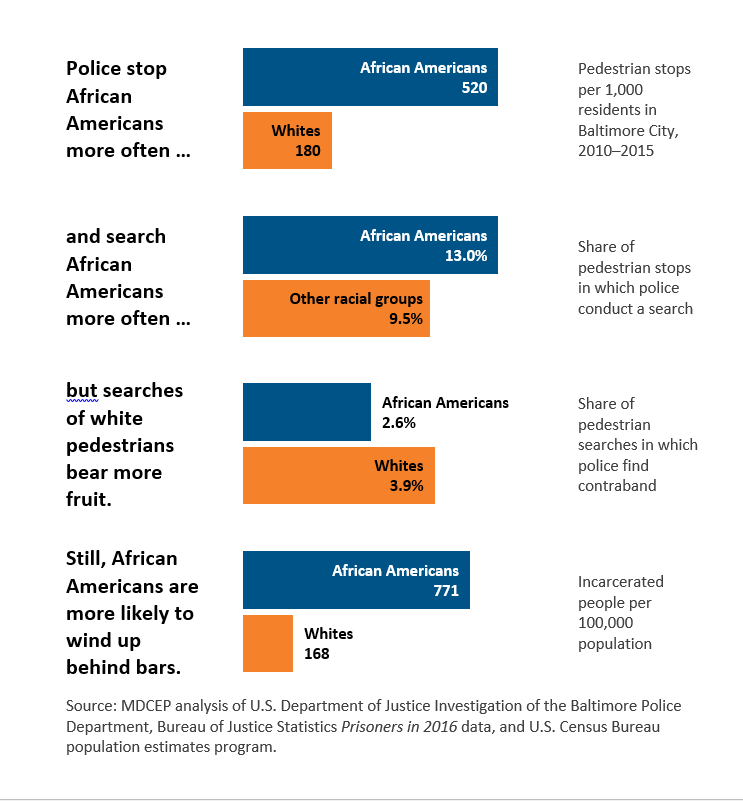Maryland Should Build on its Past Success in Reducing Incarceration
The number of people confined in Maryland prisons declined by 10 percent in 2017, a steeper drop than in any other state. This is cause to celebrate as well as a sign that reforms the state has enacted in recent years, like the Justice Reinvestment Act, are working. At the same time, Maryland still has a long way to go to bring our judicial policies in line with international norms, and legislation enacted earlier this year threatens to reverse our recent progress. Rather than double down on counterproductive practices from our past, we should build on our recent success by ensuring that all Marylanders can access due process, good jobs, and opportunity.
A recent report from the Vera Institute of Justice found that Maryland in 2017 saw the largest decline of any state in both the number of people we incarcerate and the share of Marylanders who are in prison or jail. We now imprison 299 out of every 100,000 residents, less than 35 other states. This is a 10 percent drop from 2016 and 28 percent below our 2007 incarceration rate. Nationwide, the share of people in state prisons went down by 1.5 percent, to 401 per 100,000 residents. Marylanders should be proud that our state has reduced its reliance on costly prisons nearly seven times as quickly as the rest of the country while also investing in more effective, common-sense solutions to maintain public safety.
Two recent judicial reforms have contributed to our declining prison population:
- The 2016 Justice Reinvestment Act reduced ineffective mandatory minimum penalties for minor offenses and modernized the way our parole and probation systems deal with technical violations. The law also reinvests the savings from reduced reliance on incarceration to increase access to addiction treatment, mental health care, and re-entry services—helping keep more people out of the criminal justice system.
- A 2017 ruling by the Maryland Court of Appeals curtailed the practice of keeping people accused of crimes in jail simply because they cannot afford to pay bail. Unaffordable bail pressures people who are often already struggling to make ends meet to plead guilty rather than sit in jail through an uncertain and potentially lengthy trial process. Reducing and ultimately eliminating the use of money bail is an important step in breaking Maryland’s poverty to prison pipeline and protecting due process.
While Maryland has made encouraging progress, there is still a long way to go. Although Maryland’s incarceration rate is lower than most U.S. states, it ranks among the highest by international standards—on par with countries like El Salvador and Cuba, the world’s third- and fourth-most incarcerated countries. The fact is, too many people in Maryland end up on a path that goes straight to prison and has no way out. Providing other routes, such as those to mental health services, addiction services, and greater access to good jobs, are more effective ways to create safer communities.
What’s more, Maryland’s continued reliance on incarceration is at odds with our commitment to maximizing freedom and opportunity for all residents of our state. Multiple factors, including unsafe neighborhoods, lack of access to good jobs, and discriminatory policing combine to put Black Marylanders behind bars at more than double the rate of other residents. Multiple independent studies have found that police stop, search, arrest, and use force against African Americans more often than against members of other racial groups. For example, the Department of Justice investigation of the Baltimore Police Department found that police stop African American pedestrians at a rate nearly three times as high as the rate at which they stop white pedestrians. Police then search Black pedestrians significantly more often than white pedestrians, even though they are 50 percent more likely to find contraband in searches of white pedestrians. These plainly discriminatory practices are unjust, they erode trust between communities and police, and they prevent us from building thriving communities in which all Marylanders are free to participate and contribute fully.

Maryland took steps in the wrong direction during the 2018 legislative session by creating a slew of new mandatory minimum sentences. Research has shown that mandatory minimums damage economically struggling communities and don’t reduce crime. They also eat up public resources that would be better invested in keeping people out of prison in the first place. Here are some of the steps we should be taking to reduce crime and create thriving communities rather than locking up more of our neighbors:
- To begin with, reverse this year’s damage by repealing newly created harmful mandatory minimums.
- Fully fund the Office of the Public Defender. The office has lost 18 percent of its positions since 2007, with staffing falling 1.5 times as fast as caseloads. Legislative analysts estimate that the office now needs 109 new workers in order to effectively deliver services. When public defenders are overstretched, people accused of crimes have little meaningful access to a fair trial.
- Invest in communities where barriers to other opportunities leave people with few good options. Things like affordable, safe housing; reliable transportation; quality schools; and workforce training that ends in a family-sustaining job would go a long way toward reducing the violence that too many Marylanders live with.
